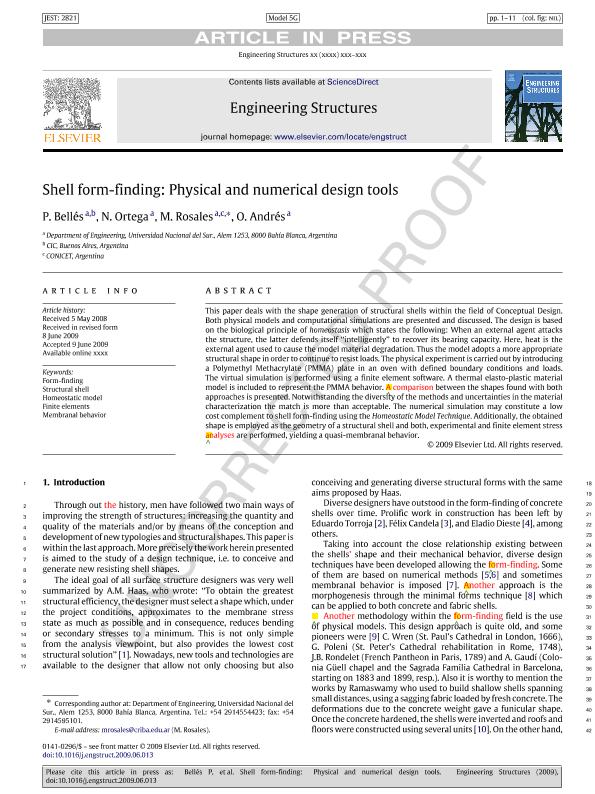Mostrar el registro sencillo del ítem
dc.contributor.author
Belles, Patricia Miriam

dc.contributor.author
Ortega, Nestor Francisco

dc.contributor.author
Rosales, Marta Beatriz

dc.contributor.author
Andrés, O.
dc.date.available
2019-02-18T19:21:50Z
dc.date.issued
2009-11
dc.identifier.citation
Belles, Patricia Miriam; Ortega, Nestor Francisco; Rosales, Marta Beatriz; Andrés, O.; Shell form-finding: Physical and numerical design tools; Elsevier; Engineering Structures; 31; 11; 11-2009; 2656-2666
dc.identifier.issn
0141-0296
dc.identifier.uri
http://hdl.handle.net/11336/70380
dc.description.abstract
This paper deals with the shape generation of structural shells within the field of Conceptual Design. Both physical models and computational simulations are presented and discussed. The design is based on the biological principle of homeostasis which states the following: When an external agent attacks the structure, the latter defends itself "intelligently" to recover its bearing capacity. Here, heat is the external agent used to cause the model material degradation. Thus the model adopts a more appropriate structural shape in order to continue to resist loads. The physical experiment is carried out by introducing a Polymethyl Methacrylate (PMMA) plate in an oven with defined boundary conditions and loads. The virtual simulation is performed using a finite element software. A thermal elasto-plastic material model is included to represent the PMMA behavior. A comparison between the shapes found with both approaches is presented. Notwithstanding the diversity of the methods and uncertainties in the material characterization the match is more than acceptable. The numerical simulation may constitute a low cost complement to shell form-finding using the Homeostatic Model Technique. Additionally, the obtained shape is employed as the geometry of a structural shell and both, experimental and finite element stress analyses are performed, yielding a quasi-membranal behavior. © 2009 Elsevier Ltd. All rights reserved.
dc.format
application/pdf
dc.language.iso
eng
dc.publisher
Elsevier

dc.rights
info:eu-repo/semantics/openAccess
dc.rights.uri
https://creativecommons.org/licenses/by-nc-sa/2.5/ar/
dc.subject
Finite Elements
dc.subject
Form-Finding
dc.subject
Homeostatic Model
dc.subject
Membranal Behavior
dc.subject
Structural Shell
dc.subject.classification
Otras Ingeniería Civil

dc.subject.classification
Ingeniería Civil

dc.subject.classification
INGENIERÍAS Y TECNOLOGÍAS

dc.title
Shell form-finding: Physical and numerical design tools
dc.type
info:eu-repo/semantics/article
dc.type
info:ar-repo/semantics/artículo
dc.type
info:eu-repo/semantics/publishedVersion
dc.date.updated
2019-02-05T19:49:19Z
dc.journal.volume
31
dc.journal.number
11
dc.journal.pagination
2656-2666
dc.journal.pais
Países Bajos

dc.journal.ciudad
Amsterdam
dc.description.fil
Fil: Belles, Patricia Miriam. Universidad Nacional del Sur; Argentina. Provincia de Buenos Aires. Gobernación. Comisión de Investigaciones Científicas; Argentina
dc.description.fil
Fil: Ortega, Nestor Francisco. Consejo Nacional de Investigaciones Científicas y Técnicas; Argentina. Universidad Nacional del Sur; Argentina
dc.description.fil
Fil: Rosales, Marta Beatriz. Consejo Nacional de Investigaciones Científicas y Técnicas; Argentina. Universidad Nacional del Sur; Argentina
dc.description.fil
Fil: Andrés, O.. Universidad Nacional del Sur; Argentina
dc.journal.title
Engineering Structures

dc.relation.alternativeid
info:eu-repo/semantics/altIdentifier/doi/https://doi.org/10.1016/j.engstruct.2009.06.013
dc.relation.alternativeid
info:eu-repo/semantics/altIdentifier/url/https://www.sciencedirect.com/science/article/pii/S0141029609002132
Archivos asociados
